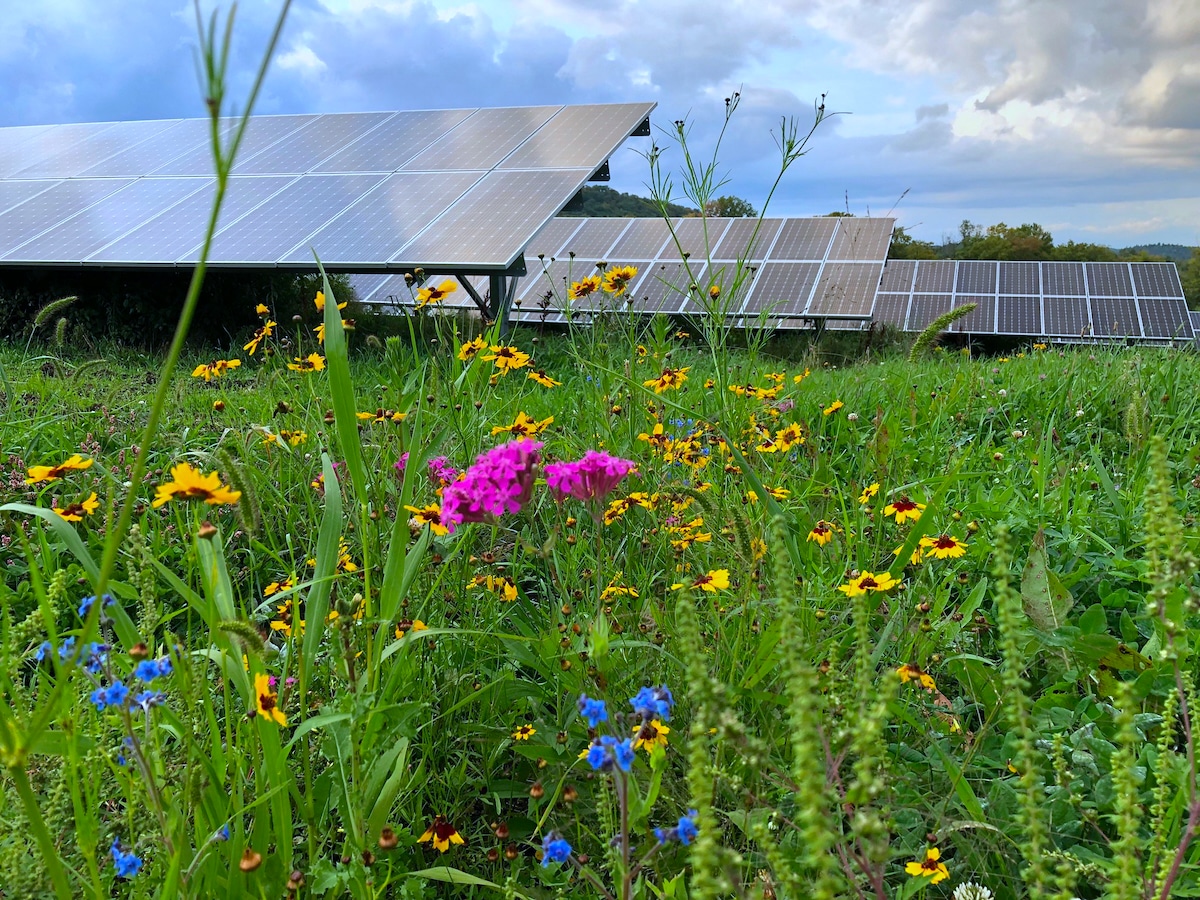Ecowatch
Pollinator-Friendly Solar Installations Can Help Solve Climate and Biodiversity Crises

Rehabilitated farmland used for solar energy facilities that are planted with native wildflowers and grasses can create lush habitats for insects, birds and bees, a new study has found.
The research, conducted by scientists with the U.S. Department of Energy (DOE)’s National Renewable Energy Laboratory and Argonne National Laboratory, found that insect numbers tripled in less than five years, a press release from Argonne National Laboratory said.
“Global declines in insect populations have important implications for biodiversity and food security,” the study’s authors wrote. “The expansion of utility-scale solar energy development in agricultural landscapes presents an opportunity for the dual use of the land for energy production and biodiversity conservation through the establishment of grasses and forbs planted among and between the photovoltaic solar arrays (‘solar-pollinator habitat’).”
For the five-year study, the researchers examined two southern Minnesota solar sites built on former agricultural land. They looked at how the newly planted vegetation would establish itself, as well as how communities of insects would respond to the restored habitat.
“This research highlights the relatively rapid insect community responses to habitat restoration at solar energy sites. It demonstrates that, if properly sited, habitat-friendly solar energy can be a feasible way to safeguard insect populations and can improve the pollination services in adjacent agricultural fields,” said lead author of the study Leroy J. Walston, who is an environmental scientist and landscape ecologist with Argonne National Laboratory, in the press release.
The study, “If you build it, will they come? Insect community responses to habitat establishment at solar energy facilities in Minnesota, USA,” was published in the journal Environmental Research Letters.
Insect biodiversity worldwide has been declining due to pesticides, habitat loss and climate change. Land-use changes for the development of renewable energy coupled with insect habitat restoration could help mitigate this ongoing crisis, Argonne National Laboratory said.
The expansion of photovoltaic (PV) solar development is essential to curbing the climate crisis. To meet climate goals, including decarbonization of the grid, much more land — roughly 10 million acres — will be needed in the United States for large-scale solar by 2050. Former farm fields are a good choice for installing rows of solar panels — much more so than previously undisturbed lands.
The combination of vegetation and agricultural management practices with solar energy production is known as agrivoltaics. One agrivoltaic strategy focuses on establishing habitat for pollinators and other wildlife that provide essential ecosystem services.
“Insects serve many roles for ecosystem function, including nutrient cycling, plant pollination and seed dispersal, maintaining soil quality, and occupying important trophic levels as both natural predators and prey,” the authors of the study wrote. “Approximately 75% of global crop production is at least partially reliant upon pollination by insects, underscoring the importance of insect pollinator conservation for human food production. In addition, insect biodiversity in agricultural landscapes is important for natural pest control, and loss of beneficial insect predators can result in reduced crop yield and increased use of pesticides.”
There has not been much field data to date documenting the ecological benefits and feasibility of pairing habitat restoration with solar energy production on previously used lands.
The solar sites in the study were planted with flowering plants and native grasses during the early part of 2018. For four years beginning in August of that year, 358 surveys were conducted by the researchers on insect communities and flowering vegetation. The team looked for shifts in insect and plant diversity and abundance each time they visited the former agricultural locations.
“The effort to obtain these data was considerable, returning to each site four times per summer to record pollinator counts,” said Heidi Hartmann, co-author of the study and manager of Argonne’s Land Resources and Energy Policy program, in the press release.
By the end of the field study, the researchers noticed increases in all biodiversity and habitat measurements. There were more flowers, native plant species and native pollinators — including bees, hornets, wasps, hoverflies, other flies, butterflies, moths and beetles. Flowering plant species and flowers had increased, the total insect population had tripled and there were 20 times more native bees. The most abundant insects in the new insect wonderland were flies, moths and beetles.
The research team also discovered that solar site pollinators visited neighboring fields and pollinated their soybeans.
The findings of the study suggest that not only can solar sites that are habitat-friendly help with biodiversity conservation, they can assist with the mitigation of land-use conflicts that can arise when converting farmland for solar production.
Agricultural lands could be used for roughly 80 percent of ground-based solar development in the future. By making marginal farmland habitat-friendly, it could be preserved and made more productive by the increased presence of healthy and robust pollinator communities.
“Solar-pollinator habitat is unlikely to completely offset the residual ecological impacts of solar developments poorly sited in areas with high ecological value. In this context, solar-pollinator habitat may have the greatest potential for ecological benefit for solar energy facilities sited in areas that have been previously ecologically compromised, such as marginal farmland, former industrial or mine lands, and other disturbed sites. In these situations, solar-pollinator habitat may be able to provide net biodiversity benefits,” the authors of the study said.
Argonne said more research is needed to know how feasible habitat-friendly solar would be in different regions with distinct ecological targets like conserving a particular wildlife or insect species.
Source
Disclaimer: No copyright infringement intended. All rights and credits reserved to respective owner(s).












